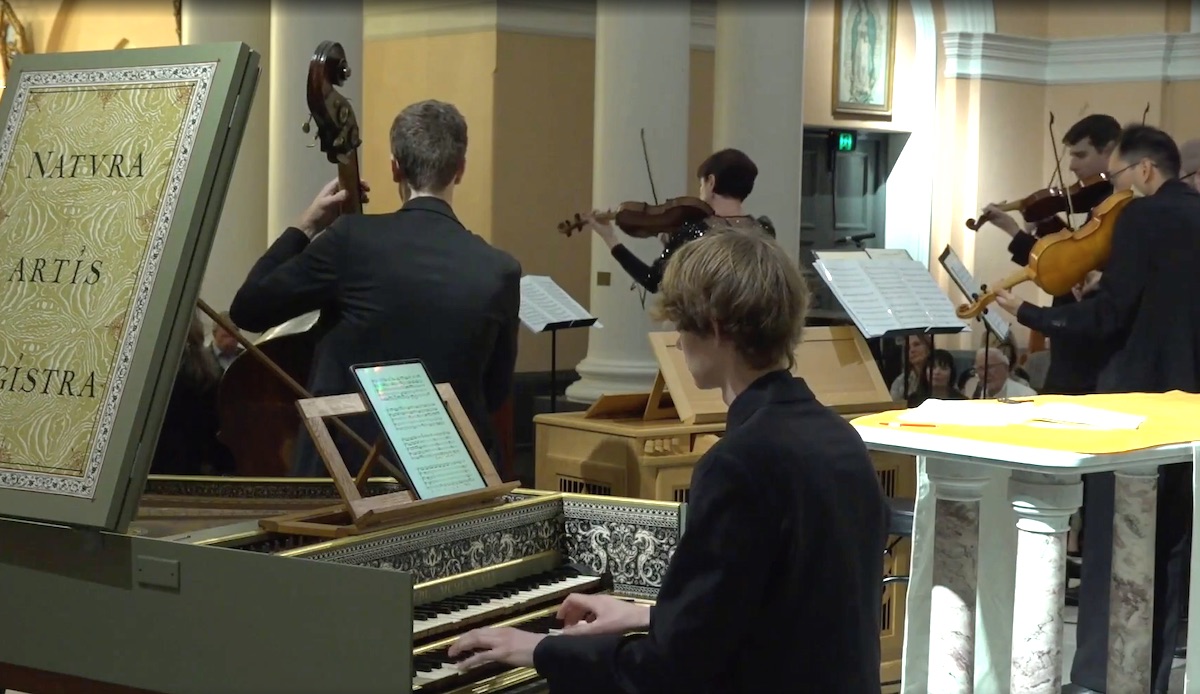Artistic Director Madeleine Easton directs and leads her specialist band of four singers and 13 period instrumentalists in two cantatas and a concerto to illustrate Bach’s work as a teacher and mentor among his many roles and the abundance of music he composed.
Dispensing with a choir for both cantatas, the choral pieces as well as the solos are sung by soprano Susannah Lawergren, alto Hannah Fraser, tenor Richard Butler and bass Andrew O’Connor. The opening chorus is monumental and the closing chorus more austere with the solos allocated to soprano, alto and bass, in this two-part cantata Brich dem Hungrigen dein Brot BWV 39.

Bach Akademie Australia performs Bach – the Benefactor. Screen capture courtesy Australian Digital Concert Hall.
Its Biblical text entreats the populace to be grateful to God and to share His gifts with the needy. The division in the movements was to accommodate the sermon. This is Bach at his sternest and most moralising, writing a cantata with a social purpose, intended to prick the conscience and focus the mind without indulging too much in the music, although it is hard not to marvel at its wonders.
The Harpsichord Concerto in E BWV 1053 arranged for Violin in D by Kati Debretzeni (the program names her as Debrezeni) is a deft inclusion.
Debretzeni has led the English Baroque Soloists, with whom Easton also performs, since 2008. She has also worked with numerous other elite Baroque ensembles, so her insights in this transcription are especially valuable. The concerto is thought to be one of eight harpsichord concertos first written for other instruments. It already exists as an oboe concerto, and in the familiar tradition of re-using his music, Bach integrated the opening movement into his Cantata BWV 169 and the third movement into the Cantata BWV 49.

Bach Akademie Australia performs Bach – the Benefactor. Screen capture courtesy Australian Digital Concert Hall.
The harpsichord version dates from Bach’s time at the Leipzig Collegium Musicum, founded by Telemann and run by Bach for many years. Busy with his family and other roles, Bach adapted and reprised existing concertos for teaching here rather than devising new material. The adaptability of the writing and Bach’s historical practice of ‘parody’, make this an apt piece for transcription and who better to accomplish this than Sir John Eliot Gardiner’s trusted orchestral leader.
As a soloist, Easton plays with virtuosic brilliance. The bubbling Allegro outer movements envelop a mesmerising and gently rocking Siciliano, which especially benefits from this transcription from harpsichord to violin as Easton spins out the poignant melody with sustained strokes of the bow.
The 10 movements of Herz und Mund und Tat und Leben BWV 147, are also in two parts, allowing the distinction of hearing the chorale Jesu, joy of man’s desiring, divinely sung by the chorus, not once, but twice, at the end of each section. The soloists give full reign to the unusually dramatic and expansive lyricism of the text in the recitatives and arias.
Lawergren, Fraser, Butler and O’Connor make a formidable quartet of well-matched voices, clear and straight-toned. They are convincing storytellers who interpret the Baroque style and ornamentation with aplomb. Lawergren conveys innocence and a lustrous purity of tone. Although much of this repertoire is set high in the voice, she maintains the space and the phrasing. The BWV 147 aria Bereite dir, Jesu, is especially pleasing, its ‘walking’ pace intertwined with the violin’s triplets gracing the melody. Her expressiveness comes to the fore in in the BWV 39 aria Höchster, was ich habe.
Fraser’s aria from BWV 39, Seinem Schöpfer noch auf Erden glistens in its combination with the oboe from Adam Masters and Easton’s violin underlay. The BWV 147 aria Schäme dich, O Seele, nicht, reprise the oboe accompaniment with the exciting addition of cello, fagotto and continuo.
Andrew O’Connor is at his didactic best, sermonising most forbiddingly in the BWV 147 aria Verstokkung kann Gewaltige verblenden and the BWV 39 aria Wohlzutun und mitzuteilen vergesset nicht.
There are not too many demands made of tenor Richard Buter with just one aria and one recitative to sing, but he is an integral part of the ensemble.
Bach’s choral parts often represented the masses; the church congregation. In the absence of a choral ensemble, the messages of the soloists and their sermons seem without direction; the choruses are pared back and missing their full-blooded earnestness.
Nonetheless, the Bach Akademie Australia consistently offers its fans the thrill of the sounds of history with instruments like the Baroque oboes, fagotto, recorders, trumpet and continuo, performing Bach’s music with style and integrity.
The unfailing beauty of the artwork chosen for the BAA’s programs and comprehensive program notes with text and translations round out a thoroughly enjoyable performance.











Comments
Log in to join the conversation.